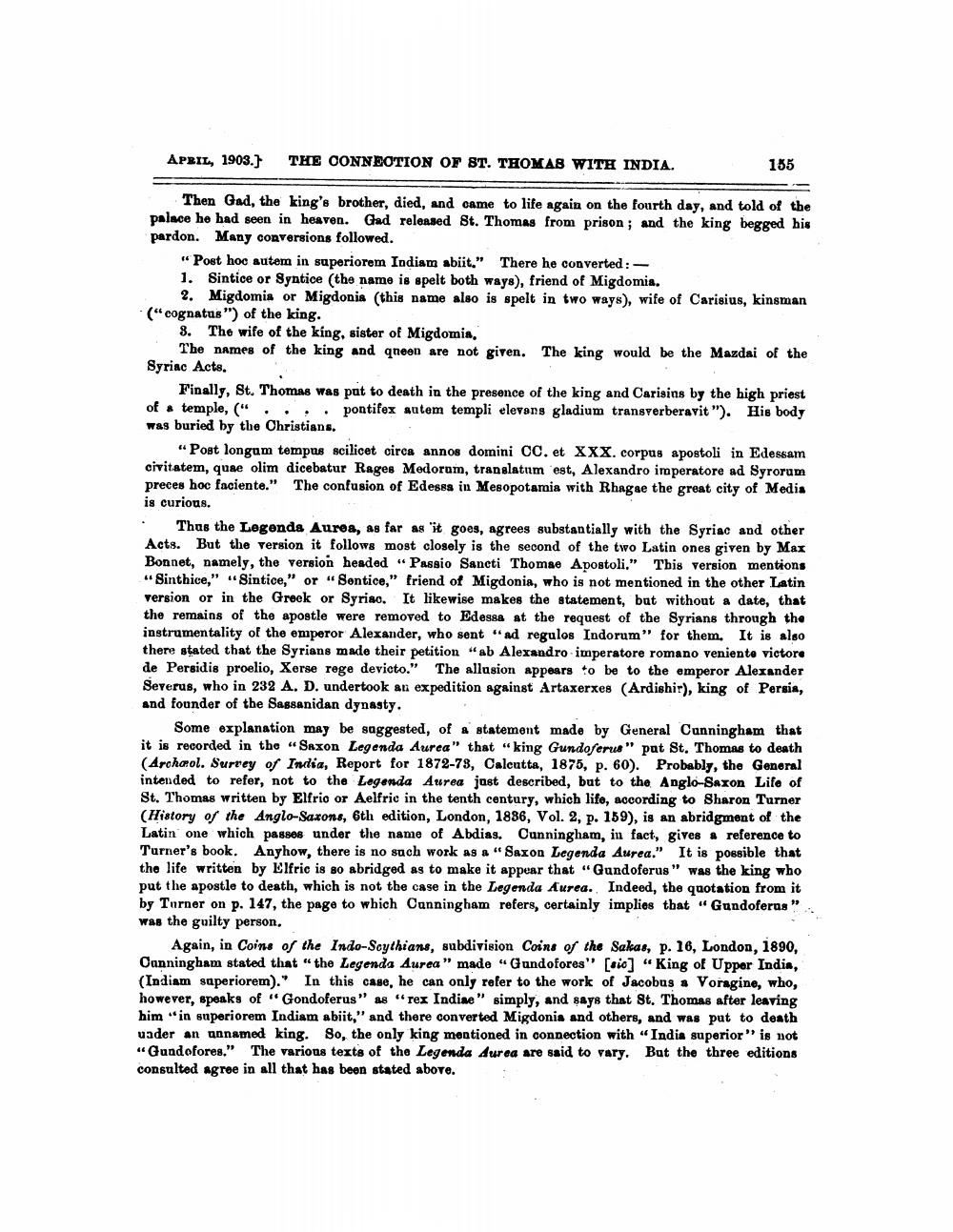________________
APRIL, 1903.)
THE OONNEOTION OF ST. THOMAS WITH INDIA.
165
Then Gad, the king's brother, died, and came to life again on the fourth day, and told of the palace he had seen in heaven. Gad released St. Thomas from prison; and the king begged his pardon. Many conversions followed.
Post hoc autem in superiorem Indiam abiit." There he converted :1. Sintice or Syntice (the name is spelt both ways), friend of Migdomia.
2. Migdomis or Migdonis (this name also is spelt in two ways), wife of Carisius, kinsman (“cognatus") of the king.
8. The wife of the king, sister of Migdomis,
The names of the king and qneen are not given. The king would be the Mazdai of the Syriac Acts.
Finally, St. Thomas was put to death in the presence of the king and Carisins by the high priest of a temple, (" ... pontifex autem templi elevans gladium transverberavit "). His body was buried by the Christians.
"Post longum tempus scilicet circa annos domini CC. et XXX. corpus apostoli in Edessam civitatem, quae olim dicebatur Rages Medoram, translatum est, Alexandro imperatore ad Syrorum preces hoc faciente." The confusion of Edessa in Mesopotamia with Rhagae the great city of Media is curious.
Thus the Legenda Aurea, as far as it goes, agrees substantially with the Syriac and other Acts. But the version it follows most closely is the second of the two Latin ones given by Max Bonnet, namely, the version headed "Passio Sancti Thomae Apostoli." This version mentions "Sinthice," "Sintice," or "Sontice," friend of Migdonia, who is not mentioned in the other Latin version or in the Greek or Syriao. It likewise makes the statement, but without a date, that the remains of the apostle were removed to Edessa at the request of the Syrians through the instrumentality of the emperor Alexander, who sent "ad regulos Indorum" for them. It is also there stated that the Syrians made their petition "ab Alexandro imperatore romano veniente vietore de Persidis proelio, Xerse rege devicto." The allusion appears to be to the emperor Alexander Severus, who in 232 A. D. undertook an expedition against Artaxerxes (Ardishir), king of Persia, and founder of the Sassanidan dynasty.
Some explanation may be suggested, of a statement made by General Cunningham that it is recorded in the "Saxon Legenda Aurea" that "king Gundoferu" pat St. Thomas to death (Archaol. Survey of India, Report for 1872-73, Calcutta, 1875, p. 60). Probably, the General intended to refer, not to the Legenda Aurea just described, but to the Anglo-Saxon Life of St. Thomas written by Elfrio or Aelfric in the tenth century, which life, according to Sharon Turner (History of the Anglo-Saxons, 6th edition, London, 1836, Vol. 2, p. 159), is an abridgment of the Latin one which passes under the name of Abdias. Cunningham, in fact, gives a reference to Turner's book. Anyhow, there is no such work as a " Saxon Legenda Aurea." It is possible that the life written by Elfric is so abridged as to make it appear that “Gundoforus" was the king who put the apostle to death, which is not the case in the Legenda Aurea. Indeed, the quotation from it by Turner on p. 147, the page to which Canningham refers, certainly implies that “Gundoferas" Was the guilty person.
Again, in Coins of the Indo-Scythians, subdivision Coins of the Sakas, p. 16, London, 1890, Canningham stated that "the Legenda Aurea" made "Gundofores" [io] “King of Upper India, (Indiam saperiorem)." In this case, he can only refer to the work of Jacobus a Voragine, who, however, speaks of "Gondoferus" as "rex Indiae" simply, and says that St. Thomas after leaving him in superiorem Indiam abiit," and there converted Migdonia and others, and was put to death uader an unnamed king. So, the only king mentioned in connection with India superior" is not "Gundofores." The various texts of the Legenda Aurea are said to vary. But the three editions consulted agree in all that has been stated above.




